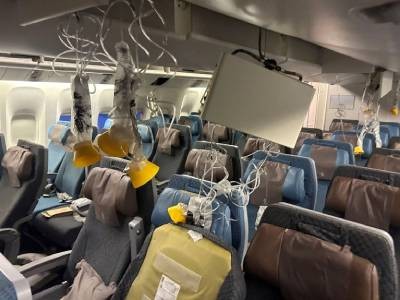Severe turbulence ahead — how scientists can keep air travellers safe in a warming world

Climate change is not just leading to more heatwaves and hurricanes — it’s making the atmosphere more turbulent, too. As I found out while flying from Kuala Lumpur to London a few weeks ago, sudden jolts from bumpy air can send your coffee flying. Riding jet streams can feel like being on a roller coaster.
Air turbulence has been in the news because dozens of passengers on a Singapore Airlines flight in May were injured and one person died when the aeroplane lost 54 metres of altitude within seconds over Myanmar. Those passengers were not just unlucky; the frequency of such events is rising, because global warming is making the air stormier.
As a researcher in fluid dynamics and climate change, I can assure you that flying remains one of the safest modes of travel. But I also know that the changing patterns of air turbulence need much more research. Scientists need to understand how climate change is altering air pressure, buoyancy and currents. Pilots need tools that can predict and pinpoint areas of extreme turbulence, which is often invisible and can hit out of the blue.
Singapore Airlines turbulence: why climate change is making flights rougher
Whereas storm clouds are obvious and can be flown around, ‘clear-air turbulence’ is invisible to the eye and to conventional radar. Climate change is increasing the severity and frequency of such atmospheric disturbances. For example, between 1979 and 2020, the frequency of severe clear-air turbulence rose by 55% over the United States and North Atlantic Ocean (M. C. Prosser et al. Geophys. Res. Lett. 50, e2023GL103814; 2023).
Global warming is altering horizontal and vertical temperature gradients in the atmosphere, affecting atmospheric stability and patterns of air movement (S. H. Lee et al. Nature 572, 639–642; 2019). For example, air turbulence often occurs around jet streams — fast air currents driven by temperature differences between the Equator and poles. Sudden changes in wind speed and direction, known as wind shear, cause bumpiness. Because polar regions are warming faster than tropical ones, climate change is reducing the temperature gradients that cause jet streams, which alters their behaviour.
Vertical temperature gradients are also affected by climate change. Greenhouse gases trap heat in the lower layers of the atmosphere and the stratosphere cools. Larger temperature gradients might lead to more frequent and intense convection, resulting in stronger storms. Planes near areas with strong convection might encounter more severe turbulence than elsewhere, making it feel as if your flight is navigating through a stormy sea.
A cleaner future for flight — aviation needs a radical redesign
Climate change is also causing gravity, buoyancy, pressure, inertia and spin to interact in the atmosphere in increasingly complex ways. For example, as Earth warms, atmospheric oscillations known as gravity waves become more frequent and intense. These waves can create turbulence by generating strong vertical wind shear. They also interact with the jet stream and other atmospheric forces, leading to more unpredictable weather patterns. Understanding such dynamic changes is crucial for developing predictive models and strategies to ensure aviation safety.
Action in three areas is needed. First, scientists can use computer simulations of Earth’s atmosphere to gain a deeper theoretical understanding of the mechanisms of air turbulence and how they are affected by climate change. The increased frequency of turbulence-related incidents provides case studies and data to refine the models.
Second, researchers need to develop technologies for detecting and forecasting air turbulence. For instance, a technology called lidar — radar using lasers instead of radio waves — is able to detect clear-air turbulence that radar cannot. However, current systems are large and heavy. More-compact and cost-effective lidar systems are urgently needed by the aviation industry. Satellites and meteorological technologies can also provide real-time data on atmospheric conditions over wide areas. These data can be fed into simulations to model turbulence along an aircraft’s path in real time. By integrating these tools and technologies, researchers can develop robust and reliable predictive models.
Third, artificial intelligence (AI) can be used to optimize predictive models. Training AI algorithms on vast data sets of air turbulence, including meteorological data, aircraft sensor readings, historical flight records, pilot reports, weather radar and lidar data, would enable them to spot subtle changes and complex patterns in turbulence, enhancing the accuracy of predictions. Using AI systems would also speed up computations, potentially making real-time turbulence predictions possible. To incorporate AI, researchers need to develop algorithms that can handle the complexity of atmospheric data, improve the accuracy and speed of simulations, and create real-time predictive systems that can be applied to enhance safety and efficiency in aviation.
Like the rest of the planet, the skies are telling a story of change: the invisible hand of global warming is stirring the atmosphere in unexpected ways. The Singapore Airlines incident must be a wake-up call. The skies might be stormier, but with effort and ingenuity, researchers can help flyers to find smoother and safer air ahead.
Competing Interests
The author declares no competing interests.








